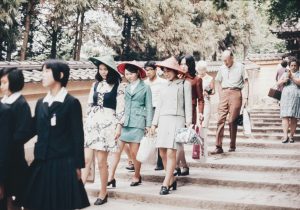Exploring the intersection of fashion and pop culture
Fashion and pop culture have always been intertwined. From the rebellious style of punk rock to the glamorous looks on the red carpet, fashion has often been a form of self-expression influenced by popular culture. As trends come and go, they leave their mark on both fashion and society. As a result, the intersection of fashion and pop culture has become a fascinating and ever-changing landscape to explore.
Pop Culture Icons and Their Influence on Fashion
One of the most significant ways pop culture affects fashion is through its icons. Whether it’s actors, musicians, or social media influencers, these figures have immense power to shape and dictate trends. For example, the iconic “Rachel” haircut popularized by Jennifer Aniston on the hit TV show Friends sparked a hairstyle craze in the ’90s, with women everywhere rushing to their hairdressers for choppy layers and face-framing highlights.
Similarly, when Beyoncé released her visual album Lemonade, it not only made a powerful statement about black womanhood, but it also influenced fashion trends. The album’s aesthetic, a mix of Southern Gothic and Afro-Caribbean styles, inspired designers to incorporate elements like high-necked Victorian-style blouses and ruffled dresses into their collections.
The Cyclical Nature of Trends
Another aspect of the intersection of fashion and pop culture is the cyclical nature of trends. What is deemed stylish or trendy often depends on the current cultural climate and popular figures. For instance, during the ’90s, grunge fashion was all the rage, influenced by the rise of alternative rock and bands like Nirvana. However, as the new millennium approached, fashion shifted towards a more glamorous and polished aesthetic, ushered in by celebrities like Britney Spears and Paris Hilton.
Today, we see a resurgence of ’90s fashion, with oversized jackets, slip dresses, and chunky sneakers making a comeback. This revival can be attributed in part to the rise of social media and the nostalgia it evokes in millennials and Gen Z. The power of pop culture to revisit and reinvent trends from the past is undeniable.
The Impact of Streetwear on Fashion
In recent years, another significant trend in the intersection of fashion and pop culture has been the rise of streetwear. What started as a subculture of skate and hip-hop fashion has now become one of the most influential forces in the industry. Streetwear brands like Supreme, Off-White, and A Bathing Ape have gained a cult following and are often seen on celebrities and influencers.
The influence of streetwear on high fashion is undeniable, with collaborations between luxury brands and streetwear labels becoming commonplace. The popularity of streetwear can be attributed to its accessibility, with its casual and comfortable aesthetic resonating with the current generation. It also reflects the blurring of lines between high and low fashion, a notion that has been amplified by the rise of social media and the democratization of trends.
The Role of Fashion in Pop Culture
As much as pop culture impacts fashion, fashion also has a significant role in shaping popular culture. With social media and the internet, fashion trends can spread like wildfire, with influencers and celebrities often at the forefront of these movements. Fashion has also become increasingly political, with designers using their platforms to raise awareness of social and political issues. For example, Maria Grazia Chiuri’s “We Should All Be Feminists” t-shirt for Dior sparked important conversations about gender equality.
In conclusion, the intersection of fashion and pop culture is a dynamic and ever-evolving landscape. From pop culture icons to the cyclical nature of trends, fashion and popular culture have a symbiotic relationship. In today’s society, where trends can spread at lightning speed, it’s essential to recognize the power and influence of this intersection and how it shapes our perceptions of style and identity.










